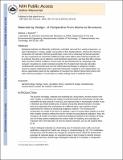Materials by design—A perspective from atoms to structures
Author(s)
Buehler, Markus J.
DownloadBuehler_Materials by.pdf (2.949Mb)
OPEN_ACCESS_POLICY
Open Access Policy
Creative Commons Attribution-Noncommercial-Share Alike
Terms of use
Metadata
Show full item recordAbstract
Biological materials are effectively synthesized, controlled, and used for a variety of purposes in Nature—in spite of limitations in energy, quality, and quantity of their building blocks. Whereas the chemical composition of materials in the living world plays some role in achieving functional properties, the way components are connected at different length scales defines what material properties can be achieved, how they can be altered to meet functional requirements, and how they fail in disease states and other extreme conditions. Recent work has demonstrated this using large-scale computer simulations to predict materials properties from fundamental molecular principles, combined with experimental work and new mathematical techniques to categorize complex structure-property relationships into a systematic framework. Enabled by such categorization, we discuss opportunities based on the exploitation of concepts from distinct hierarchical systems that share common principles in how function is created, even linking music to materials science.
Date issued
2013-02Department
Massachusetts Institute of Technology. Department of Civil and Environmental Engineering; Massachusetts Institute of Technology. School of EngineeringJournal
MRS Bulletin
Publisher
Cambridge University Press (Materials Research Society)
Citation
Buehler, Markus J. “Materials by design—A Perspective from Atoms to Structures.” MRS Bulletin 38, no. 02 (February 2013): 169–176.
Version: Author's final manuscript
ISSN
0883-7694
1938-1425